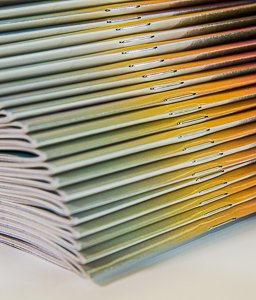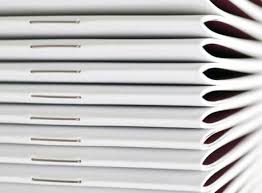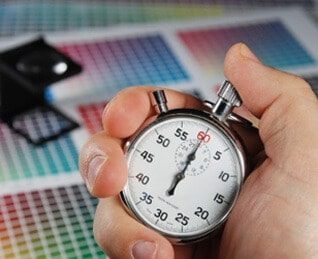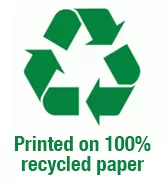
Choosing the right binding technique for booklets, brochures, and magazines is essential. Stitched printing, also known as saddle stitch book printing, is a specialty of MVP Print. It’s ideal for projects with 8 to 76 pages, fitting well for marketing materials, magazines, and presentations. When uploading artwork for printing booklets, it is important to include a front cover design file that matches the selected dimensions and is clearly labeled for proper processing.
Saddle stitch booklets are more affordable for small print runs compared to complex methods like perfect binding. This technique provides a polished finish, appealing to high-end audiences. It’s also quick and easy, making it perfect for urgent projects. Plus, its minimal weight helps keep shipping costs down. Both self cover and hard cover options are available for saddle-stitched booklets, with hard cover products featuring a cover printed on heavier paper compared to the internal pages, thus offering extensive customization possibilities.
Introduction to Stitched Printing
Stitched printing, also known as saddle stitching, is a widely used and affordable binding method. It’s ideal for creating booklets, brochures, catalogues, and marketing materials. This method involves folding paper in half and stapling it along the spine, with the number of sheets determining the total printed pages (PP). This results in a booklet that lies flat and looks professional.
Definition of Stitched Printing
Saddle stitching binds pages by folding them in half and stapling along the spine. This technique produces a neat, professional booklet. The cumulative thickness of the inner pages affects the booklet’s structure and appearance, making it versatile and accommodating various page counts and customization options.
Advantages of Stitched Printing for Multi-Page Materials
- Cost-effective and efficient binding solution for small to medium-sized print runs
- Produces a professional and polished appearance for booklets, brochures, and catalogues
- Versatile in accommodating a wide range of page counts, from 8 to 64 pages typically
- Allows for various paper stocks, including uncoated and coated options, to suit different design needs
- Compact and lightweight format, leading to lower shipping and distribution costs
- Faster production times compared to other binding methods due to the simplicity of the process
- Self cover option available, providing a seamless look and cost-effective choice for various booklet sizes and types
Stitched printing, or saddle stitching, is a cost-effective and professional option for multi-page materials. It’s a favourite across many sectors due to its efficiency and quality.
Types of Stitched Printing
Saddle stitched printing is a popular binding method used for booklets, magazines, and catalogs. There are several types of stitched printing, each catering to different needs and preferences:
- Saddle Stitching: This is the most common type of stitched printing, where the pages are folded in half and stapled together along the spine. It’s ideal for creating professional-looking booklets that lie flat and are easy to read. Saddle stitching is perfect for marketing materials, brochures, and catalogues with a moderate number of pages.
- Side Stitching: For booklets that require a more secure binding, side stitching is an excellent option. In this method, the pages are stapled along the side of the booklet, providing extra durability. This binding method is suitable for thicker publications or materials that will be frequently handled.
- Loop Stitching: Loop stitching involves stapling the pages together with a loop of wire, creating a more durable binding. This method is often used for booklets that need to withstand heavy use, such as manuals or instructional guides. The loops also allow the booklet to be easily inserted into binders or folders.
Saddle Stitch Binding: A Popular Stitched Printing Method

Saddle stitching is a prevalent and economical binding technique in the printing sector. It involves folding multiple sheets of paper in half, placing them across a “saddle,” and then stapling them together along the spine with two wire staples. The cumulative thickness of the inner pages affects the booklet’s structure and appearance, ensuring the booklet lies flat, ideal for documents with 8 to 76 pages.
What is Saddle Stitching?
Saddle stitched booklets cater to a broad spectrum of printed materials, from marketing materials to catalogues and brochures. This technique folds the printed pages in half and secures them with wire staples along the spine, where ‘PP’ stands for ‘printed pages’. It results in a refined and professional appearance.
Benefits of Saddle Stitching for Booklets and Brochures
- Compact and cost-effective design
- Ability to accommodate a wide range of page counts, from small booklets to thicker publications
- Flat opening for easy reading and viewing
- Suitable for a variety of printing needs, including marketing materials, catalogues, and newsletters
- Self cover option as a cost-effective choice that provides a seamless look for various booklet sizes and types
Saddle stitching is a versatile and efficient binding method. It enables the creation of high-quality printed materials with a professional finish. It’s suitable for both small booklets and larger publications, offering numerous benefits to meet diverse needs.
Stitched Printing: Cost-Effective and Quick Turnaround

Saddle stitch binding is a cost-effective option compared to other bookbinding methods. It’s particularly beneficial for stapled books, brochures, and similar printed materials. The setup is straightforward, involving folding sheets in half and stapling along the crease. This simplicity reduces production costs and setup time.
Moreover, saddle stitch binding is versatile, suitable for both small and large print runs. This versatility makes it a practical choice for various printing needs. Both self cover and hard cover options are available for saddle-stitched booklets, with hard cover products featuring a cover printed on heavier paper compared to the internal pages.
Choosing MVP Print for your saddle-stitched booklets means enjoying an ultra-fast turnaround time. Artwork supplied print-ready or approved by 10 am can be printed the same or next day, 99% of the time. This makes stitched printing perfect for urgent marketing collateral, catalogues, and brochures.
The number of pages in saddle-stitched booklets ranges from 8pp to 80pp, meeting diverse needs. Saddle Stitched Magazines with a 250gsm cover are ideal for high-quality product catalogues, community magazines, and family cookbooks. Those with a 350gsm cover are suitable for photography books, art books, and yearly reports. For a budget-friendly option, black and white printing is recommended for sheet music booklets, colouring-in books, product manuals, instructional booklets, and textbooks.
Whether you need a small or large print run, MVP Print’s stitched printing offers a professional finish, quick turnaround, and cost-effective solution. Contact us for a personalized quote and let us help bring your vision to life.
Ideal Page Range for Stitched Printing
In the realm of stitched printing, the optimal page count for a saddle-stitched booklet is generally between 60 to 70 pages. This range ensures the booklet maintains its shape and pages stay securely bound. The cumulative thickness of the inner pages affects the booklet’s structure and appearance, ensuring quality without the need for extra binding materials or techniques.
Recommended Maximum Page Count
Booklets with under 8 pages might lack substance, while those over 76 pages can be cumbersome. As page count grows, the booklet’s thickness becomes a limiting factor. For saddle-stitched booklets, the number of printed pages (PP) directly affects the binding process and overall feel. This can make the publication feel too bulky, negatively impacting the reading experience.
Considerations for Higher Page Counts
For projects with more pages, perfect binding might be a better choice to keep the look professional and cohesive. This method allows for thicker booklets without sacrificing quality or usability. Choosing the right binding method depends on the project’s specific needs, including page range, cover options, and desired aesthetic. A cost-effective option to consider is the ‘self cover,’ where all pages, including the covers, use the same type and weight of paper, providing a seamless look suitable for various booklet sizes and types.
Booklet Sizes and Formats
Saddle stitched booklets come in a variety of sizes and formats to suit different needs. Some common sizes include:
- A4: 210 x 297 mm – Ideal for detailed brochures and catalogs.
- A5: 148 x 210 mm – Perfect for compact booklets and manuals.
- A6: 105 x 148 mm – Great for small brochures and flyers.
- DL: 99 x 210 mm – Suitable for slim, elegant brochures.
- Square: 210 x 210 mm – Excellent for unique, eye-catching designs.
Booklets can also be printed in various formats, including:
- Portrait: Where the booklet is printed with the longer edge vertical. This format is traditional and widely used for most booklets and brochures.
- Landscape: Where the booklet is printed with the longer edge horizontal. This format is ideal for showcasing wide images and graphics.
- Square: Where the booklet is printed with equal dimensions. This format offers a modern and stylish look, perfect for creative projects.
Stitched Printing for Smaller and Larger Print Runs
Businesses have the flexibility to choose between different methods for stitched printing, depending on their print run needs. For smaller print runs under 500 booklets, the standard saddle-stitching approach is a great choice, offering various specifications and options for printed pages. This method is cost-effective and efficient, making it perfect for businesses, event promotions, and marketing campaigns.
Hand-Fed Saddle Stitching for Smaller Print Runs
The hand-fed saddle stitching process involves manually inserting each booklet into the stitching machine. The cumulative thickness of the inner pages affects the booklet’s structure and appearance, which is then bound together using wire staples. This method is ideal for small-scale projects, offering a professional finish at a reasonable cost. Businesses can use this technique to produce high-quality stapled booklets, catalogues, and brochures without overspending.
High-Speed Saddle Stitching for Larger Print Runs
For print runs in the thousands or more, businesses might opt for the high-speed saddle stitching approach. This automated process uses wire staples (spooled) machinery to bind booklets. It’s a practical choice for materials, product catalogues, and extensive publications. The high-speed saddle stitching process allows for efficient and cost-effective booklet production, even at larger scales. Additionally, the ‘self cover’ option, where all pages including the covers use the same type and weight of paper, provides a seamless look and is a versatile, cost-effective choice for various booklet sizes and types.
Alternative Binding Options
Saddle stitching is a favourite for its affordability and effectiveness. Yet, other binding methods exist for unique printing needs. These alternatives offer a range of benefits, from a polished finish to the robustness needed for certain publications. Additionally, both self cover and hard cover options are available for saddle-stitched booklets, with hard cover products featuring a cover printed on heavier paper compared to the internal pages, thus providing extensive customization possibilities.
Perfect Binding
Perfect binding, or adhesive binding, is a top pick for softcover books and magazines. It employs a robust adhesive to secure pages along the spine, achieving a refined appearance. Ideal for books over 96 printed pages, it ensures durability and a sophisticated look for items like brochures and reports.
Coil or Wire-O Binding
Coil or wire-o binding stands out for its ability to allow books to lie flat and rotate fully. This method uses a wire or plastic coil through pre-punched holes, making it perfect for manuals and workbooks. The cumulative thickness of the inner pages can affect the booklet’s structure and appearance, so careful design considerations are necessary to ensure quality printing outcomes. It’s also great for presentations, offering flexibility and customisation options for various paper types and designs.
Paper Options for Stitched Printing
At MVP Print, we provide a wide range of paper options for your stitched printing needs. Whether you’re crafting a vibrant booklet, a sophisticated brochure, or a professional catalogue, our paper stocks can help you achieve the perfect look and feel. This ensures your project stands out. One cost-effective option is the ‘self cover,’ where all pages, including the covers, use the same type and weight of paper, providing a seamless look suitable for various booklet sizes and types.
Coated Paper for Vibrant Images and Graphics
For booklets and brochures with vivid images and captivating graphics, our coated paper options are ideal. The glossy surface enhances colour vibrancy and detail sharpness, making visuals pop. This paper is perfect for creating striking booklets, brochures, and catalogues that impress your audience. Additionally, our saddle-stitched booklets can be customized with various specifications, including the number of printed pages (PP), which is crucial for determining the number of sheets and the binding process.
Uncoated Paper for a Natural, Matte Look
For a more understated, elegant look, our uncoated paper stocks are ideal. With a matte finish, it offers a natural, sophisticated appearance. It’s great for content-rich booklets or projects with a minimalist design. The cumulative thickness of the inner pages can affect the booklet’s structure and appearance, making it essential to consider this in your design. It’s also a sustainable choice for eco-friendly printing.
Recycled Paper Options for Sustainable Printing

At MVP Print, we value environmental sustainability. That’s why we offer recycled paper options for booklets, brochures, and catalogues with a reduced environmental impact. Choosing recycled paper shows your brand’s commitment to sustainability, appealing to eco-conscious consumers.
Additionally, we provide a ‘self cover’ option where all pages, including the covers, use the same type and weight of paper. This cost-effective choice offers a seamless look and is versatile for various booklet sizes and types.
Our team of experts is ready to help you choose the perfect paper stock. Whether you have specific design preferences or project requirements, we aim to deliver a professional finish and the quality your audience expects.
Stitched Printing: Design Considerations
Creating engaging marketing materials like product catalogues, magazines, and brochures with stitched printing requires careful design. At MVP Print, we grasp the significance of accurate bleed and trim details for a top-notch finish. It is also crucial to include a front cover design file when uploading artwork for printing booklets, ensuring it matches the selected dimensions and is clearly labeled for proper processing.
Bleed and Trim Specifications
MVP Print advises adding a 3mm bleed area around the artwork to cover any trimming errors. This ensures the design covers the entire booklet, avoiding white edges. When considering saddle-stitched booklets, it’s important to note that ‘PP’ stands for ‘printed pages,’ which refers to the total number of pages, including the cover. Such precision is vital for a smooth, professional look.
File Formatting and Page Count Guidelines
For superior printing, MVP Print demands files in PDF format, with a minimum of 300 dpi resolution. This maintains the sharpness of images, text, and graphics. Clients must adhere to specific page counts, ensuring a multiple of four pages, including covers. The cumulative thickness of the inner pages affects the booklet’s structure and appearance, and additional bleed might be needed for thicker booklets to prevent edge shifts.
Additional Services
In addition to saddle stitched booklet printing, we also offer a range of additional services to enhance your booklets, including:
- Lamination: A clear plastic coating applied to the cover to protect and enhance the appearance of the booklet. Lamination adds durability and a polished finish, making your booklets more resistant to wear and tear.
- Folding: Booklets can be folded to create a compact size, making them easier to distribute and store. This service is particularly useful for brochures and flyers that need to be mailed or handed out at events.
- Drilling: Holes can be drilled into the booklet for binding or other purposes. This is ideal for booklets that need to be inserted into binders or used in conjunction with other materials.
- Perforation: Lines can be perforated into the booklet to create tear-out pages or coupons. This feature is perfect for booklets that include forms, vouchers, or detachable sections.
Customisation Options for Stitched Printing
At MVP Print, we grasp the significance of crafting a unique, professional, and eye-catching final product for your multi-page marketing materials. We provide a variety of customisation options for stitched printing, including both self cover and hard cover options for your saddle-stitched booklets. This allows you to enhance your booklets, brochures, and other printed materials.
Self Cover Finishes and Embellishments
The cover finishes we offer include a glossy sheen, a matte look, and a soft, velvet touch. These options significantly boost the overall look of your booklet. They capture your audience’s attention and strengthen your brand’s image.
Our stitched printing services also include embellishments like foiling, embossing, and die-cutting. These premium finishes can be applied to your cover. They create a truly unique and memorable piece that distinguishes itself from others.
When uploading artwork for printing booklets, it is crucial to include a front cover design file that matches the selected dimensions and is clearly labeled for proper processing.
Whether you’re creating product catalogues, promotional booklets, or any other multi-page printed material, these customisation options enable you to produce a professional and visually appealing final product. This aligns with your brand’s identity.
Common Uses for Stitched Booklets

Saddle stitched booklets are commonly used for a variety of purposes, including:
- Magazines and Catalogues: Saddle stitched booklets are ideal for magazines and catalogs that require a high-quality finish and a secure binding. They provide a professional look and are easy to handle.
- Brochures and Flyers: Saddle stitched booklets are great for brochures and flyers that require a compact size and a professional finish. They are perfect for marketing campaigns and promotional materials.
- Programs and Guides: Saddle stitched booklets are often used for programs and guides that require a secure binding and a high-quality finish. They are suitable for events, conferences, and instructional materials.
- Menus and Price Lists: Saddle stitched booklets are commonly used for menus and price lists that require a compact size and a professional finish. They are ideal for restaurants, cafes, and retail stores.
By choosing saddle stitched booklets, you can create professional, durable, and visually appealing materials that effectively convey your message and make a lasting impression on your audience.
Conclusion
Stitched printing, especially saddle stitching, is a versatile and cost-effective binding method. It suits a broad spectrum of printed materials, from marketing materials and catalogues to booklets and brochures. Its professional look, quick production time, and customisation options make stitched printing perfect for those seeking top-notch, visually appealing multi-page printed items. The specifications and options available for saddle-stitched booklets include the number of printed pages (PP), which is crucial in determining the number of sheets and the binding process.
MVP Print excels in stitched printing, offering a vast array of paper choices and finishing options. This ensures clients can craft booklets that resonate with their brand and design ethos. Whether it’s a small batch of saddle stitched booklets or a large-scale saddle stitch booklet printing endeavour, MVP Print’s team is there to assist. They help with everything from picking the right paper stocks and cover artwork to adding creative touches that make your booklets truly unique.
Utilising a stitched printing process allows you to produce professional, robust, and eye-catching bound booklets. These can effectively convey your message and make a significant impact on your target audience. Reach out to MVP Print to discuss your unique requirements and discover the customisation possibilities for your next booklet printing venture.








